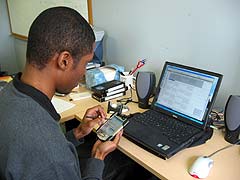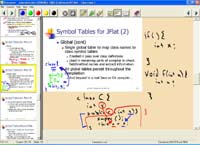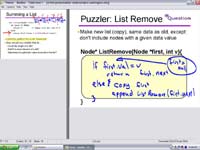REDMOND, Wash., Feb. 19, 2003 — Jeff Pierce has a knack for turning pet peeves into full-blown obsessions. As a graduate student, Pierce was continually frustrated with all the work he had to do to synchronize the files on his desktop PC with those on his laptop.
Working on his thesis in the evening, he’d often realize he’d forgotten to copy the latest version of it from his desktop at school. Working from his desktop, he’d frequently find an e-mail message that he needed to review was actually on his laptop. Pierce believed there had to be a better way to coordinate activities among his devices — and finally he’s set out to prove it.

A user accesses his calendar for the entire week on his laptop, and at the same time use his PDA screen to see the details of a single day’s schedule, using Pierce’s “Personal Information Environment” technology. Click image for hi-res version.
Now an assistant professor in the computer science department at the Georgia Institute of Technology, Pierce and his colleagues have jumpstarted a research project that aims to replace the old computer model of “one device at a time” with a new paradigm, in which a variety of devices — such as laptops, desktop PCs, PDAs and cell phones — are aware of one another and their user, and can coordinate their activities. This roving “Personal Information Environment” will eventually allow a user to add other devices, such as monitors, keyboards and mice, on the fly and from any location. A user carrying a cell phone, for instance, could connect the device to any nearby monitor to display her monthly schedule, rather than trying to view it on the cell phone’s small screen.
Pierce’s ambitious vision has caught the attention of Microsoft Research (MSR), the companys computer-science arm, which this year is awarding funding for the project as part of its annual Innovation Excellence program. Georgia Tech, in Atlanta, is one of more than 24 universities around the globe awarded funding from MSR to conduct research in different areas of emerging technology. MSR will announce the recipients of this years award program at SIGCSE 2003, an annual technology symposium devoted to computer science education, taking place from Feb. 19-23 in Reno, Nev.
Now in its second year, the Innovation Excellence program reflects Microsoft’s commitment to strengthen collaboration between the company and academia in developing new and advanced technologies. This year the program garnered 152 submissions, almost double the number received last year, and will award US$3.5 million to the various chosen projects.
“We strongly believe universities are key collaborators in driving new innovation that impacts society,” says Douglas Leland, director of MSR’s University Relations Group. “By collaborating together we hope to advance not only the dialogue of innovation, but the pace of innovation as well.”
MSR will place no restrictions on how the money is used, and, while there is a remarkable diversity of projects, they fall into five main areas of emerging technology: mobility, security, distributed computing, learning sciences, and Tablet PC technologies.
A Jump-Start on Innovation
At Georgia Tech, Pierce plans to use the gift from MSR to hire a graduate assistant to work on the project and to provide equipment to some of his students so that they also can work on different aspects of the project.
“As a new faculty member at Georgia Tech, MSR’s funding is invaluable because it allows me to get a head start on my research. In only my second semester here, I can get students started on interesting parts of the overall project and a graduate assistant to help oversee it,” Pierce says.
The first phase of Pierce’s research will center on making devices just a little bit smarter so that they can do some of the coordination among devices that users currently have to do for themselves.
“Users may synchronize the data on their PDA and desktop PC, but they really aren’t using these devices together,” says Pierce. “I typically work with my PDA docked next to my laptop, but despite the fact that they’re both my devices and sitting right next to each other, they arent able to really augment each other.”
The goals of the Georgia Tech project are twofold. One is to make a device like the PDA augment the desktop by providing information or controls focused on enhancing the user’s interaction with the desktop. For example, if you’re working on a document in Microsoft Word on your desktop, it can be counterproductive to toggle between applications to see if important e-mail is waiting in your inbox or who might be available via instant messaging to answer your questions. Pierce and his colleagues want to be able to offload that kind of information to the PDA so that you could simply glance over at your PDA to see that you have e-mail from your boss, reach over with one of your hands and touch that information to pull it up on your desktop screen, address it, and then continue to work on your project.
The other goal of the project involves enabling PDAs and cell phones so that other devices like monitors and keyboards can be connected to them on the fly, thereby increasing mobile users’ productivity.
“Mobile devices will never be large because users need to be able to slip them in their pockets. We want to augment them so that users can draw on other devices in the environment that will allow them to interact as if they were carrying a large keyboard, mouse and display with them,” says Pierce.
Because Pierce’s project is focused on users interacting with multiple devices, the research is centered on systems that are running the Microsoft Windows CE and Windows XP operating systems. Students are using Microsoft Visual Studio .NET and Microsoft’s eMbedded Visual Tools to develop prototype applications for evaluation, and Pierce hopes to explore using the .NET Compact Framework and C# to create cross-functionality among devices.
Better Classroom Technology Via the Tablet PC
While the goal of the Georgia Tech project is to increase productivity by developing a Personal Information Environment, another award recipient–this time in the Learning Sciences category–is focusing on increasing the quality of classroom presentations by developing better technology based on the Tablet PC.
One of the biggest frustrations that college faculty face is how to give presentations based on lecture slides and still remain flexible in interacting with the students in the classroom, says Richard Anderson, professor of computer science at the University of Washington (UW) in Seattle. To solve this problem, Anderson has been working in tandem with Microsoft researchers to develop and deploy a Tablet PC-based lecture presentation system that researchers hope will increase opportunities for interaction with students.
Using this system, an instructor holds a Tablet PC that is wirelessly connected to another computer driving a classroom projector. The instructor displays slides from a Tablet PC and can customize the lecture by writing notes on top of the slides and in the margins of the screen. The Tablet PC makes it possible to combine the strengths of computer-based slides with the flexibility of a whiteboard.

Richard Anderson’s Tablet PC combines the strengths of computer-based slides with the flexibility of a whiteboard. Click image for hi-res version.
While this much of the system may not dramatically alter the age-old model of the university lecture, Anderson is hoping that the second phase of the project will. The next step, which will be carried out at UW and funded by MSR, involves integrating student devices, such as laptops, Tablet PCs and Pocket PCs, into the system so that students can more easily contribute to the lectures and participate in structured interactions. To develop this capability, researchers are using the Tablet PC and doing all of their development using C# and .NET technologies.
In this type of scenario, an instructor might ask students to take a moment to write a few lines of code based on a presentation slide, which is viewable on both the data projector and on the students’ wireless devices. The students compose their solutions using their Tablet PCs or other devices, writing on the presentation slide. When the lecturer asks for a volunteer who’d like to share his or her solution, the lecturer can bring that student’s code up on the public display.

Students could use their computing devices to contribute directly to classroom lectures. Click image for hi-res version.
“We want to make it easier for students to contribute to lectures and for instructors to customize material on the fly as they deliver their lecture,” says Anderson. “The long-term impact will be to improve the university lecture by using technology to mitigate some of the problems of large class sizes.”
MSR funding for the project is absolutely critical, according to Anderson. His team includes a number of graduate and undergraduate students who are contributing to the development of the system. And the project requires a range of Tablet PCs to support evaluation in a broad range of courses, including both large lecture and distributed classes.
“Aside from the funding, our direct collaboration with Microsoft Research in the early phase of the project has been indispensable. Having access to the expertise laid the foundation for the system,” Anderson says.
Project Presentations at Fourth Annual Faculty Summit
Representatives of the Georgia Tech and University of Washington research projects will be among several Innovation Excellence recipients on hand at the fourth annual MSR Faculty Summit this July in Redmond, Washington, to demonstrate their research. The Faculty Summit is a forum for university faculty to learn about the latest Microsoft technologies and to build peer-to-peer relationships that will lead to research projects that serve the technology industry as a whole.
“Mobility, security, distributed computing — these are some of the key technology areas that are driving some really compelling scenarios with software and technologies,” says Microsoft’s Leland. “Microsoft is honored to partner with professors and students who are leading the exploration in these and other important areas of computer science.”
Innovation Excellence Program Recipients




